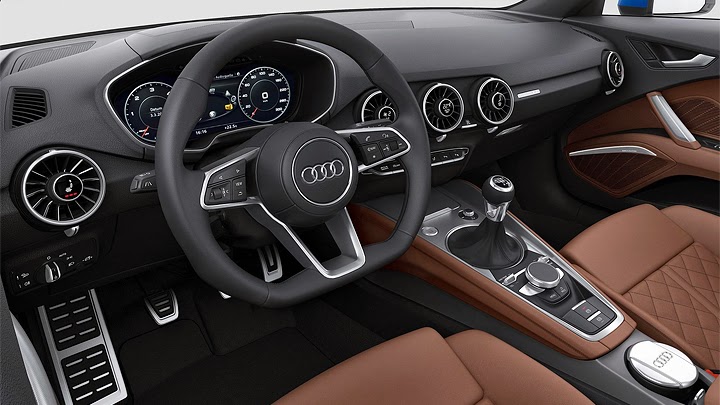
Like what happens with solo singers and bands, using the term “icon” frequently starts debates whose duration is as big as the participants’ knowledge – or good mood, in less desirable cases. After all, it’s extremely hard for an artist to be respected and acclaimed by people interested in other branches of music as much as its own fans do. Going back to cars, this would be the reason why examples such as Chevrolet Corvette, Citroën DS, Ford T, Land Rover Range Rover or Porsche 911 (among others) are so important. There are plenty of people who join only one of these “teams” and don’t care for the others, but they always allow themselves exceptions like those. Since that level of recognition is so hard to reach, those who are still on the way usually receive more specific titles.
One of those could be “modern-day icon”, which fits TT perfectly while avoiding conflict with Mustang fans, for example. Audi’s coupé was a huge success since those ‘1995 concept cars. The use of straight lines and smooth surfaces was strong enough to maintain its connection with the company’s design language of the late 1990s, but pairing it to that unique silhouette amazed everyone. It didn’t use anything complex, and some could say anything new, neither, but this is precisely one of the reasons of such approval. TT presented a typical coupé image (later joined by a roadster) which looked solid, rather than investing on distractions like flashy accessories. It managed to survive almost untouched until 2006, when the second generation arrived.








Having a whole new structure cleared the way for several mechanical improvements, as well as the even sportier TTS and TT RS. There were design changes, too, but all of them focused on enhancing the original image, rather than creating a new one. Audi certainly had the same intention this time, but it seems like its current design rules appeared a little stronger than they should. Using a whole new front fascia in 2006 was great because it would be very nice for TT to stop resembling a ‘1995 Ford Fiesta, but the current case didn’t have any problem like that. The company logo went to the hood just like R8’s, the headlights shrunk more than ever, but both have the job to take the attentions to a main grille that looks a little exaggerated this car.
However, if the front fascia looks like it was originally created for another car, you can still recognize TT by its other zones. Besides the overall silhouette, the sides repeated nice elements like the crease over the front wheel and the silver fuel cap, which appeared at the first phase. The rounded rear has slightly smaller tail lights, whose internal design uses the same square elements as the front set. Less obvious are the three-dimensional details, which didn’t appear at the outgoing car. You can spot them at the connection between headlights and front grille and at the tiny tailgate, for instance. Such level of external similarity with the outgoing car was already expected from a German automaker, but the truth is it’s just as expected as a completely reworked interior.








VW Group’s ubiquitous MQB platform appears once again, bringing all-aluminum body with high-strength steel structure to this car, with a subsequent 50-kg lighter weight. The cabin, in turn, can be considered modern even for the current standards. TT took most of the function controls to an infotainment central’s screen, just like any other modern car, but it honored the fact of not being a family car: such 12.3” display appears as the instrument cluster, therefore being accessible only to the driver. It serves Audi’s Virtual Cockpit system, and features many customizing options with 3D-effect graphics. Such strategy freed the dashboard to look cleaner than ever, using very nice ideas like placing the climate controls at the vents’ centers.
The only point where this car is actually similar to its predecessor is the powertrain options. The diesel 2.0L can be taken also with front-wheel-drive now, and reaches 184 hp, 28.6 kpl and 110 g/km of CO2. The gasoline range starts with a TSI 2.0L capable of 227 hp, which uses six-speed manual transmission and goes from 0 to 100 kph in 6s. Change it to the S-Tronic gearbox and add the quattro traction, and that time lowers to 5s3. The next option would be TTS, which takes the power to 306 hp and the acceleration time to 4s7. If you want even more, the new TT RS should arrive next year, featuring a five-cylinder 2.5L engine with 400 hp and capable of reaching 100 kph in 4s, always using the seven-speed S-Tronic. The new Audi TT will hit European streets later this year.
Lançamento no Brasil (15/05/2015)
Chega ao Brasil a mais nova geração do menor cupê da Audi. O novo TT associa o estilo icônico à extensa série de evoluções detalhadas no texto acima. Suas versões são Attraction, custando R$ 209.990, e Ambition, por mais R$ 20 mil. Ambas usam o motor 2.0 TFSI, de 230 cv e 37,7 kgfm, e o câmbio S Tronic, com seis marchas e dupla embreagem – ele acelera de 0 a 100 km/h em 5,9 e chega a 250 km/h, mas consegue fazer 9,9 km/l na cidade, 12,7 km/l na estrada, e emitir 123,8 g/km de CO2. Quanto a equipamentos, a maioria dos destaques é da Ambition: o Drive Select traz três modos de condução, os farois usam LEDs (xenônio na outra), e o quadro de instrumentos é o Virtual Cockpit. A lista de equipamentos, naturalmente, é enorme nos dois casos.